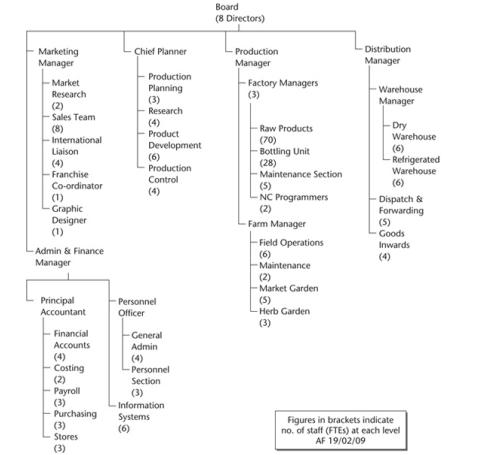Reread the description of the FoodCo case study in Case Study B1. Identify any constraints that you
Question:
Reread the description of the FoodCo case study in Case Study B1. Identify any constraints that you think might be imposed on the design of the new system.
FoodCo Case Study:
FoodCo produces a range of perishable foods for supermarkets and is based in the flat
agricultural lands of the East Anglia region of the UK. John Evans, the present Chairman,
started the company when he left the Royal Air Force. He borrowed money to buy 200 acres
(81 hectares) of arable farmland, but his ambition was to be more than a farmer. As soon as
Home Farm was running he opened a factory in a converted barn.
The first product was a pickle made to a traditional family recipe. It sold well, and success
financed expansion. Soon John was able to acquire derelict land next to the farm and the
company moved into a larger, purpose-built factory. The product range extended to pre-packed
vegetables and salads, and later a wide range of sauces, pickles and sandwich toppings, in
fact almost anything made of vegetables that can be sold in jars. FoodCo’s traditional
customers are major UK supermarket chains. Some lines (e.g. washed salads) sell to all
customers, while others (most of the cooked products) are produced for a specific supermarket
chain. Most are packaged under the supermarket’s ‘own brand’ label.
The pickle started a company tradition that, as far as possible, ingredients are grown on the
company’s own farm. This now covers 1500 acres (607 hectares) and includes a market
garden growing tomatoes, peppers, courgettes, chillies and other exotic vegetables under
glass, and an extensive herb garden. Ingredients that do not grow well in the UK climate are
sourced from carefully selected farms abroad, in Mediterranean Europe, East Africa, the USA
and the Far East.
The company’s annual turnover and employee numbers are summarized in Fig. B1.1.
Figure B1.1:

There are now three factories on the site. Beechfield is the oldest, and this is where raw
vegetables are prepared. This work is relatively unskilled. The newer Coppice and Watermead
factories concentrate on the more complex cooking processes involved in making sauces,
pickles and the like. These need more skilled and experienced staff. A bottling plant is also
located in Watermead, and there are two warehouses in separate buildings. One is
refrigerated and stores fresh vegetable and salad packs, while the other stores dry and bottled
products. Figure B1.2 shows a recent organization structure chart.
Figure B1.2:
 The company is still privately owned and managed, with John’s elder son Harold now the
The company is still privately owned and managed, with John’s elder son Harold now the
Managing Director and John keeping more in the background. When Harold took over, it was
generally agreed by the Board that the company must improve profitability but there was no
consensus on how to achieve this. John persuaded the Board that FoodCo must bypass its
traditional supermarket customers and market directly to consumers. As a result of his analysis
(Box B1.1 gives an edited version of his last speech to the Board as Managing Director), the
‘World Tradition’ range was launched. This now sells successfully at the quality end of the UK
market. Helped by the growing respect for British food and cooking, the range has also begun
to penetrate continental European and North American markets.
Box B1.1:
‘Fellow directors, we all know the company faces great difficulties. This year’s profits will be the
lowest ever. If we don’t do something drastic, we’ll be bankrupt in another year. But if we are to turn. the situation round, we must understand why things are so difficult for us now.
‘I believe the reason goes right back to our beginnings. Those of you who were with me in 1967,
when I started this company, will remember having a degree of control that seems incredible now.
Everything ran the way we wanted: farm, production, sales, distribution. We made consistently high
quality goods, and by 1972 the new supermarkets were clamouring to buy. That was all a long time
ago, but I think that early success is a direct cause of our present predicament. Let me explain.
‘But remember 1978? When we borrowed heavily to finance expansion to meet the demand?
Those loan repayments squeezed our profits hard. And then in 1984? When the TrustMart chain
emerged as our dominant customer, and began driving down prices? We simply hadn’t the financial
muscle to fight them. We were still paying off a huge loan! Ever since then, TrustMart has dictated
prices so low they have crippled us. We’ve been unable to do a thing about it, because we’ve
simply been scared they’ll go to our competitors for their supplies. Last year TrustMart bought 65%
of our total production—altogether over £5m in sales—and we’ll be lucky to clear £200,000 profit on
it!
‘That’s also why TrustMart calls all the shots on new products. We don’t have the cash to
develop products for other customers. Now, I know we’ve grown in spite of that. It’s not all been
bad, but let’s not kid ourselves it’s been good. We haven’t really run the game since 1990. We all
know it! We’ve been towed along behind TrustMart—and the supermarket sector—like a child
dragged along by its father. We’ve only survived this long because TrustMart had no other suppliers
big enough to meet their needs. But now that’s changing. We have serious new rivals for the
supermarket supply business, and TrustMart has driven our prices still lower, to the point where we
may make no profit at all this year.
‘We can beat off this attack, but only if we develop new products and sell in a wider market.
There is no argument about that, but there is a problem. Our real customers are not the
supermarkets, but their shoppers. And they don’t know we exist, because our name is hidden
behind all the TrustMart own-brand labels on all our packs and jars. The answer is to reach the
consumers directly. Our market can only expand if they know our name, if they ask for our
products. So here’s what we will do. We’re going to launch our own brand name, and promote it so
well that everyone knows about us. Customers will begin to insist on our brand, and TrustMart will
have to pay our price, for a change.
‘It won’t be cheap. We’ll need serious market research. We’ll need more staff in the Product
Development team, and we’ll need time. We’ll need a new corporate image. We’ll need TV
advertising. But it will be worth it. There’s a vast market out there, and I’m not just thinking of the
UK.
‘So can we finance it? Certainly! It means more heavy borrowing, but our profits on increased
sales will repay the loan. It’s a big risk, but we’ll sink if we don’t take it. There are many details to
work out, but this plan can succeed. It will succeed! When I started out, we were the best in the
business. I believe we can be the best again.
Step by Step Answer:

Object-Oriented Systems Analysis And Design Using UML
ISBN: 9780077139711
4th Edition
Authors: Simon Bennett, Steve McRobb, Ray Farmer





